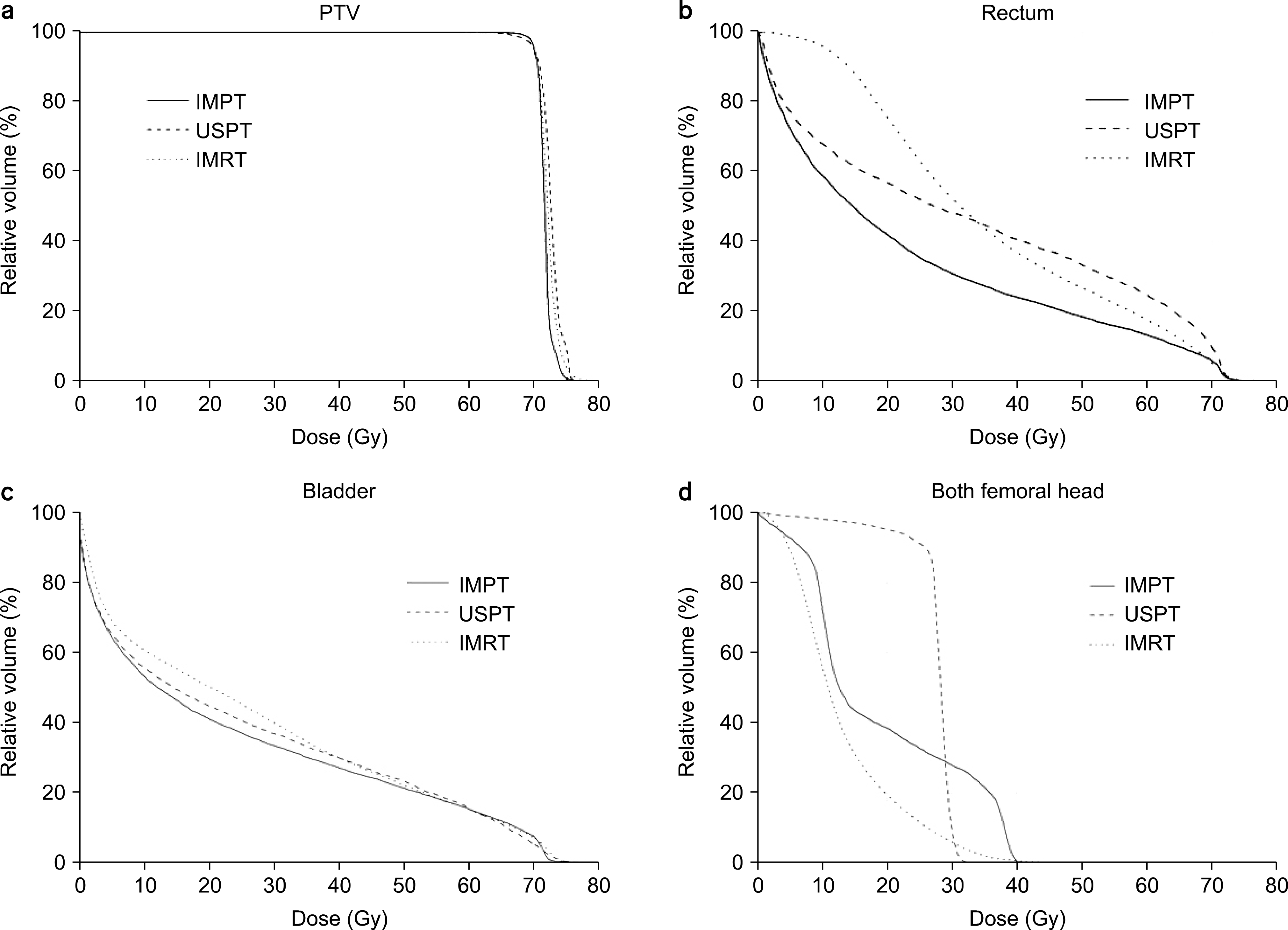Abstract
This study assessed compared photon and proton treatment techniques, such as intensity modulated radiation therapy (IMRT), uniform scanning proton therapy (USPT), and intensity modulated proton therapy (IMPT), for a total of 10 prostate cancers. All treatment plans delivered 70 Gy to 95% of the planned target volume in 28 fractions. IMRT plans had 7 fields for the step and shoot technique, while USPT and IMPT plans employed two equally weighted, parallel-opposed lateral fields to deliver the prescribed dose to the planned target. Inverse planning was then incorporated to optimize IMPT. The homogeneity index (HI) and conformity index (CI) for the target and the normal tissue complication probability (NTCP) for organ at risk (OAR) were calculated. Although the mean HI and CI for target were not significantly different for each treatment techniques, the NTCP of the rectum was 2.233, 3.326, and 1.707 for IMRT, USPT, and IMPT, respectively. The NTCP of the bladder was 0.008, 0.003, and 0.002 respectively. The NTCP values at the rectum and bladder were significantly lower using IMPT. Our study shows that using proton therapy, particularly IMPT, to treat prostate cancer could be beneficial compared to 7-field IMRT with similar target coverage. Given these results, radiotherapy using protons, particularly optimized IMPT, is a worthwhile treatment option for prostate cancer.
Go to : 
REFERENCES
1. Ferlay J, Shin HR, Bray F, Forman D, Mathers C, Parkin DM. Estimates of worldwide burden of cancer in 2008: GLOBOCAN 2008. International J of Cancer. 127(12):2893–2917. 2010.

2. Weber DC, Trofimov AV, Delaney TF, Bortfeld T. A treatment planning comparison of intensity modulated photon and proton therapy for paraspinal sarcomas. Int J Radiat Oncol Biol Phys. 58(5):1596–1606. 2004.

3. Chung JB, Kim TS, Kim IA, Lee JW, Cho W, Suh TS. The effect of photon energy on the intensity-modulated radiation therapy plan for prostate cancer: a planning study. Korean Phys Soc. 59(1):183–188. 2011.

4. Trofimov A, Nguyen PL, Coen JJ, et al. Radiotherapy treatment of early-stage prostate cancer with IMRT and protons: a treatment planning comparison. Int J Radiat Oncol Biol Phys. 69(2):444–453. 2007.

6. Jones B, Burnet N. Radiotherapy for the future - Protons and ions hold much promise. British Medical J. 330(7498):979–980B. 2005.
7. Goitein M, Lomax AJ, Pedroni ES. Weighing proton therapy's clinical readiness and costs. Physics Today. 56(6):13–14. 2003.

8. Kase Y, Yamashita H, Fuji H, et al. A treatment planning comparison of passive-scattering and intensity-modulated proton therapy for typical tumor sites. J of Radiation Research. 2011.
9. Nutting CM, Convery DJ, Cosgrove VP, et al. Reduction of small and large bowel irradiation using an optimized intensity-modulated pelvic radiotherapy technique in patients with prostate cancer. Int J Radiat Oncol Biol Phys. 48(3):649–656. 2000.

10. Lomax A. Intensity modulation methods for proton radiotherapy. Phys Med Biol. 44(1):185–205. 1999.

11. Oelfke U, Bortfeld T. Inverse planning for photon and proton beams. Med Dos. 26(2):113–124. 2001.

12. Cella L, Lomax A, Miralbell R. Potential role of intensity modulated proton beams in prostate cancer radiotherapy. Int J Radiat Oncol Biol Phys. 49(1):217–223. 2001.

13. Steneker M, Lomax A, Schneider U. Intensity modulated photon and proton therapy for the treatment of head and neck tumors. Radiat Oncol. 80(2):263–267. 2006.

14. Huchet A, Caudry M, Belkacemi Y, et al. Volume-effect and radiotherapy [II]. Part II: volume-effect and normal tissue. Cancer Radiotherapie. 7(5):353–362. 2003.
15. Mohan R, Wu Q, Manning M, Schmidt-Ullrich R. Radiobiological considerations in the design of fractionation strategies for intensity-modulated radiation therapy of head and neck cancers. Int J Radiat Oncol Biol Phys. 46(3):619–630. 2000.

16. Dearnaley DP, Hall E, Lawrence D, et al. Phase III pilot study of dose escalation using conformal radiotherapy in prostate cancer: PSA control and side effects. British J of Cancer. 92(3):488–498. 2005.

17. Peeters ST, Heemsbergen WD, Koper PC, et al. Doseresponse in radiotherapy for localized prostate cancer: results of the Dutch multicenter randomized phase III trial comparing 68 Gy of radiotherapy with 78 Gy. J of Clinical Oncology. 24(13):1990–1996. 2006.

18. Pollack A, Zagars GK, Starkschall G, et al. Prostate cancer radiation dose response: results of the M. D. Anderson phase III randomized trial. Int J Radiat Oncol Biol Phys. 53(5):1097–1105. 2002.

19. Michalski JM, Winter K, Purdy JA, et al. Toxicity after three-dimensional radiotherapy for prostate cancer on RTOG 9406 dose Level V. Int J Radiat Oncol Biol Phys. 62(3):706–713. 2005.

Go to : 
 | Fig. 1.Color wash IMRT (a), USPT (b), and IMPT (c) dose distribution for the PTV for patient (patient 3) with a prostate cancer. It shows the dose distributions of IMRT, USPT, and IMPT plans for CT image on axial, frontal, and sagittal planes, respectively. IMPT and USPT dose distributions delivered by right lateral (270°) and left lateral (90°) beams. |
Table 1.
Characteristics of the 10 prostate patients.
Table 2.
Optimization constraints for IMRT and IMPT.
Table 3.
Conformity indexes (CI) and homogeneity indexes (HI) were represented for IMPT, USPT, and IMRT at PTV.
Table 4.
NTCP values for the rectum and bladder of 10 patients.




 PDF
PDF ePub
ePub Citation
Citation Print
Print



 XML Download
XML Download